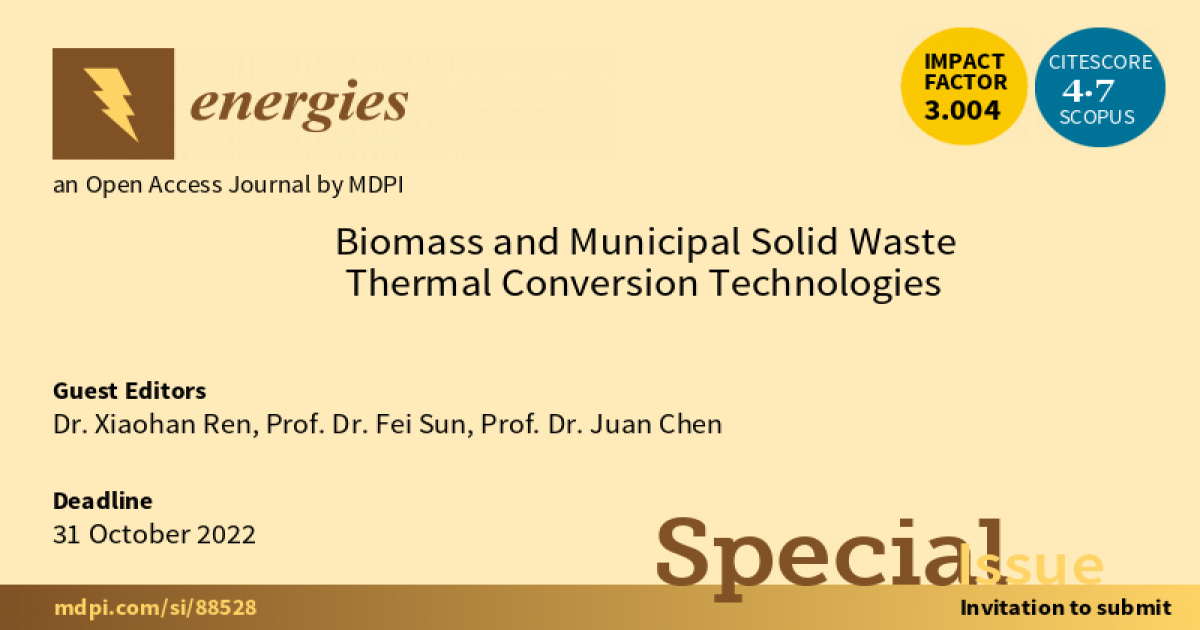Biomass and Municipal Solid Waste Thermal Conversion Technologies
A special issue of Energies (ISSN 1996-1073). This special issue belongs to the section "A4: Bio-Energy".
Deadline for manuscript submissions: closed (31 October 2022) | Viewed by 11612

Special Issue Editors
Interests: biomass pyrolysis; biomass combustion; biomass gasification; biomass utilization; combustion analysis
Special Issues, Collections and Topics in MDPI journals
Interests: carbon-based materials for energy or environment; electrochemical energy conversion and storage (Li/Na ion batteries/capacitors, EDLCs, electrocatalysis); coal-based carbon materials; coal pyrolysis; pollutants recyclable/synergistic removal technology
Special Issues, Collections and Topics in MDPI journals
Interests: solid fuels; clean combustion; pollutants control; coal combustion; oxy-fuel combustion
Special Issues, Collections and Topics in MDPI journals
Special Issue Information
Dear Colleagues,
Climate change is among the most pressing challenges of the 21st century. Concerns about the environmental impact of greenhouse gas emissions from burning fossil-based fuels have promoted the use of renewable sources of energy. These include renewable biomass, which is readily available. Notably, during the past few decades, municipal solid waste (MSW) has been drastically increasing around the world as a result of the growing urbanization. The development of the utilization of alternative resources has raised a number of other tasks and constraints linked to the nature of renewable resources, including the treatment, processing, thermal conversion, and applied technologies, and, thus, a large number of critical views on this issue. Hence, in this research topic, different kinds of “Thermal Conversion Technologies” for biomass and MSW utilization could be discussed herein.
Dr. Xiaohan Ren
Prof. Dr. Fei Sun
Prof. Dr. Juan Chen
Guest Editors
Manuscript Submission Information
Manuscripts should be submitted online at www.mdpi.com by registering and logging in to this website. Once you are registered, click here to go to the submission form. Manuscripts can be submitted until the deadline. All submissions that pass pre-check are peer-reviewed. Accepted papers will be published continuously in the journal (as soon as accepted) and will be listed together on the special issue website. Research articles, review articles as well as short communications are invited. For planned papers, a title and short abstract (about 100 words) can be sent to the Editorial Office for announcement on this website.
Submitted manuscripts should not have been published previously, nor be under consideration for publication elsewhere (except conference proceedings papers). All manuscripts are thoroughly refereed through a single-blind peer-review process. A guide for authors and other relevant information for submission of manuscripts is available on the Instructions for Authors page. Energies is an international peer-reviewed open access semimonthly journal published by MDPI.
Please visit the Instructions for Authors page before submitting a manuscript. The Article Processing Charge (APC) for publication in this open access journal is 2600 CHF (Swiss Francs). Submitted papers should be well formatted and use good English. Authors may use MDPI's English editing service prior to publication or during author revisions.
Keywords
- Thermochemical conversion (combustion, pyrolysis, gasification) of biomass
- MSW drying, incineration and pyrolysis
- Physical conversion (pelletizing, densification, extraction)
- Liquid biofuels such as biodiesel, bioethanol and bio-oils
- Life-cycle analysis of the conversion process
- Carbon materials based on biomass and MSW
- Other thermal conversion technologies on biomass and MSW






